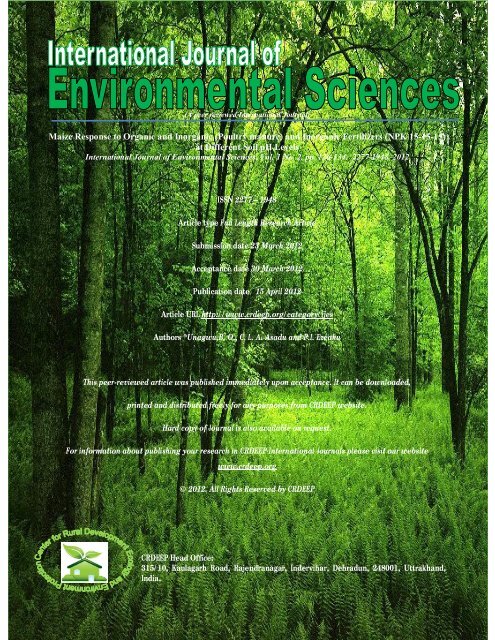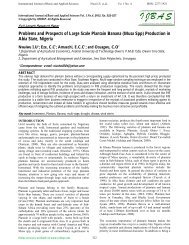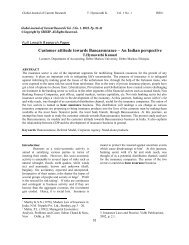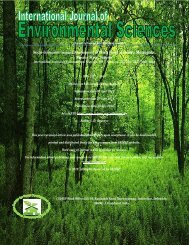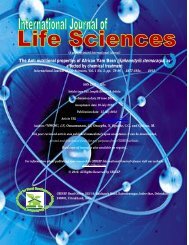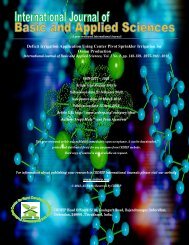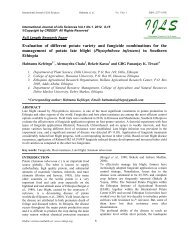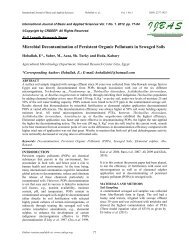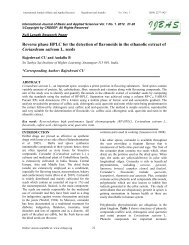Download Pdf - CRDEEP
Download Pdf - CRDEEP
Download Pdf - CRDEEP
Create successful ePaper yourself
Turn your PDF publications into a flip-book with our unique Google optimized e-Paper software.
International Journal of Environmental Sciences Unagwu et. al., Vol.1 No.2 ISSN: 2277-1948<br />
(A peer reviewed International Journal)<br />
Maize Response to Organic and Inorganic (Poultry manure) and Inorganic Fertilizers (NPK 15-15-15)<br />
at Different Soil pH Levels<br />
International Journal of Environmental Sciences, Vol. 1 No. 2. pp. 126-134. 2277-1948. 2012<br />
ISSN 2277 – 1948<br />
Article type Full Length Research Article<br />
Submission date 23 March 2012<br />
Acceptance date 30 March 2012<br />
Publication date 15 April 2012<br />
Article URL http://www.crdeep.org/category/ijes<br />
Authors *Unagwu,B. O., C. L. A. Asadu and P.I. Ezeaku<br />
This peer-reviewed article was published immediately upon acceptance. It can be downloaded,<br />
printed and distributed freely for any purposes from <strong>CRDEEP</strong> website.<br />
Hard copy of Journal is also available on request.<br />
For information about publishing your research in <strong>CRDEEP</strong> International Journals please visit our website<br />
www.crdeep.org<br />
© 2012. All Rights Reserved by <strong>CRDEEP</strong><br />
<strong>CRDEEP</strong> Head Office:<br />
315/10, Kaulagarh Road, Rajendranagar, Indervihar, Dehradun, 248001, Uttrakhand,<br />
India.<br />
Online version is available at: www.crdeep.org
International Journal of Environmental Sciences Unagwu et. al., Vol.1 No.2 ISSN: 2277-1948<br />
International Journal of Environmental Sciences Vol.1 No.2. 2012. Pp. 126-134<br />
©Copyright by <strong>CRDEEP</strong>. All Rights Reserved<br />
Full Length Research Paper<br />
Maize Response to Organic and Inorganic (Poultry manure) and Inorganic Fertilizers (NPK<br />
15-15-15) at Different Soil pH Levels<br />
*Unagwu,B. O., C. L. A. Asadu and P.I. Ezeaku<br />
Department of Soil Science, University of Nigeria, Nsukka<br />
*Corresponding Author: Unagwu,B. O<br />
ABSTRACT<br />
A greenhouse experiment was carried out on an acid soil to investigate the effect of combination of organic (poultry manure) and<br />
inorganic fertilizer (NPK 15-15-15) on maize (M-S variety) performance at different soil pH levels. This was followed by a field trial<br />
to validate the findings from the greenhouse experiment. Four soil pH levels: pH 5.5, pH 6.0, pH 6.5 and pH 7.0 and six rates of<br />
treatment combination: T1 (200kg/ha NPK + 6t/ha PM); T2 (300kg/ha NPK + 4 t/ha PM), T3 (400kg t/ha NPK + 2t/ha PM); T4<br />
(400 t/ha NPK only), T5 (8t/ha PM only); T6 (Control) and replicated three times were carried out in a 6x4factorial in Completely<br />
Randomized Design (CRD) and Randomized Complete Block Design (RBCD) respectively. The study results obtained showed<br />
that plant growth, dry matter and fruit yields of maize were significantly increased due to application varying combinations of organic<br />
(poultry manure) and inorganic fertilizer at different soil pH levels, when compared with the control. The performance was in the<br />
following other: T2 and T1 at soil pH 5.5 < T1 and T2 at soil pH 7.0. The results obtained in the field were similar to the trend<br />
observed in the pot study.<br />
Thus, for better yield and productivity of maize crop, the use of T1 (200Kg/ha NPK + 6t/ha Poultry Manure) in a soil limed to pH<br />
5.5 is recommended.<br />
Key words: Lime, maize performance, inorganic fertilizer, poultry manure, soil acidity<br />
INTRODUCTION<br />
Maize (Zea mays L.) is the third most important cereal crop<br />
in the world after wheat and rice with respect to area of<br />
coverage and productivity. It is one of the most widely<br />
grown cereals in the world and has great significance as<br />
human food, animal feed and raw material for large number<br />
of industrial products. Maize has high production potential<br />
especially under irrigated condition when compared to any<br />
other cereal crop. The productivity of maize largely depends<br />
on its nutrient requirement and management particularly that<br />
of nitrogen, phosphorus and potassium(Arunkumar 2007)<br />
Soil acidity is the most important cause of low yield for<br />
many crops (Hoekenga and Pineros 2004; Lucia et al, 2010).<br />
About 30% of the world’s soils are acidic, and 60% of them<br />
are in tropical and subtropical areas associated with long<br />
periods of hot and moist weather (Hoekenga and Pineros,<br />
2004). Soil acidification is an increasing problem in the<br />
world because of acid rain, removal of natural plant<br />
coverage from large production areas and the use of<br />
ammonium-based fertilizers (Johnson et.al, 1997).<br />
One of the major problems associated with soil acidification<br />
is aluminum (Al) phytotoxicity. Aluminum is the principal<br />
component of mineral soils and is present in a wide range of<br />
primary and secondary minerals (Sommers and Lindsa,<br />
1979). Soil acidity is a threat to crop production. It is<br />
common in all regions where precipitation is high enough to<br />
leach appreciable amounts of exchangeable bases from the<br />
soil surface.<br />
Liming is an ancient rehabilitating agricultural material for<br />
soil acidity. The overall effects of lime on soils include<br />
among others, increase in soil pH, Ca and Mg saturation,<br />
neutralization of toxic concentrations of aluminum, increase<br />
in pH dependent CEC resulting in increase in P availability<br />
and improved nutrient uptake by plants (Oguntoyinbo,<br />
1996). Kamprath and Foy (1971) reported that liming effect<br />
on P- availability of highly weathered soils varied from<br />
favourable to detrimental. Liming to pH 7 however,<br />
drastically reduced P uptake from acid, aluminous Latosols.<br />
According to Konsler1 and Shelton (1990), Dolomitic<br />
limestone contributed Ca and Mg directly to the soil.<br />
Although response to lime is frequently subtle (in contrast to<br />
the quick green-up that nitrogen application gives to corn),<br />
ignoring its regular use limits crop yields. Proper use of<br />
lime, in combination with other sound agronomic and pest<br />
control practices, increased crop income in North Carolina<br />
(Crozier and Hardy, 2003).<br />
Adequate nutrient supply is essential for optimum<br />
production of maize. Due to high cost and scarcity of<br />
mineral fertilizer, most farmers cannot afford the use of<br />
chemical fertilizer. This necessitates research on organic<br />
wastes that are cheap, readily available and environmentally<br />
friendly which can be used as fertilizer. (Ayeni, 2011).<br />
Combination of organic and mineral fertilizer nutrient<br />
sources have been shown to result in synergistic effects and<br />
improved nutrient release and uptake by crop leading to<br />
higher yields. Leucaena biomass combined with mineral<br />
fertilizer gave higher crop yields as compared to sole use of<br />
mineral fertilizer or sole leucaena biomass (Mugendi et al.,<br />
Online version is available at: www.crdeep.org<br />
126
International Journal of Environmental Sciences Unagwu et. al., Vol.1 No.2 ISSN: 2277-1948<br />
1999). Mbah and Onweremadu (2009) observed that organic<br />
and inorganic amendments improved the physicochemical<br />
properties of the studied soil.<br />
Addition of organic matter (pressmud) improves soil<br />
nutrient availability and uptake by plants (Marschner, 1995).<br />
Soil pH is greatly influenced by addition of organic matter<br />
(OM) through different organic amendments and change in<br />
pH varies with the nature of OM (Walker et al., 2004).<br />
Application of organic manures significantly increased<br />
levels of organic C and N and the formation of water-stable<br />
aggregates, as compared with application of chemical<br />
fertilizers (Adrien, 2006). Aziz et al., (2010) suggested that<br />
integrated use of organic manure with chemical fertilizers<br />
would be a better and practical approach to sustain soil<br />
fertility and productivity. There have been many researches<br />
carried out on the combined effects of organic and inorganic<br />
fertilizers on growth and yield of maize (Mbah and<br />
Onweremadu, 2009). Katerji et al., (1996), suggested that<br />
better utilisation of soil nutrients for high grain yield of<br />
maize is attained under the influence of certain<br />
physicochemical soil characteristics such as pH, electrical<br />
conductivity as well as CaCO 3 and organic matter content.<br />
However, there has not been adequate research on maize<br />
response to combined organic and inorganic fertilizers at<br />
different soil pH levels.<br />
The benefits derivable from the use of organic materials<br />
have not been fully utilized in the humid tropics due to the<br />
huge quantities required to satisfy the nutritional needs of<br />
crops as well as transportation and handling costs which<br />
constitute major constraints. They are rarely available to the<br />
small-scale farmers in the required large quantities (Nyathi<br />
and Campbell, 1995). The objective of this research is to<br />
evaluate the effect of combination of organic and inorganic<br />
fertilizers on maize performance in soils of different pH<br />
levels.<br />
MATERIALS AND METHODS<br />
Location<br />
The study was carried out on Soil Science Teaching and<br />
Research farm behind the metrological station, University of<br />
Nigeria, Nsukka. The site is located at latitude 06 o 52 1 N and<br />
longitude 07 o 24 1 E with an elevation of 447m above the sea<br />
level. Rainfall is bimodal; the rainy (April – October) and<br />
the dry seasons (November – March). There is usually a<br />
short break (August Break) in the month of August. The site<br />
has an average annual rainfall of about 1600mm with an<br />
average minimum and maximum temperature of about 22 o C<br />
and 30 o C respectively.<br />
The relative humidty is rarely below 60% (Asadu et. al,<br />
2002). The soils of the area have high percentage sand and<br />
granular structure at the top and the topsoil is characterised<br />
by rapid to very rapid permeability (Obi and Asiebgu,<br />
1980). The soil is an Ultisol which belongs to Nkpologu<br />
series (Nwadialo, 1989). The soil is very deep, dark-reddish<br />
brown at the top layer and reddish in the subsoil. It is coarse<br />
to medium textured, granular in structure, acid in reaction<br />
and low in nutrient status. Its clay mineralogy is composed<br />
mainly of kaolinite and quartz (Akamigbo and Igwe, 1990).<br />
Greenhouse trials<br />
The greenhouse experiment was a 6 x 4 factorial with three<br />
replications laid out in Completely Randomized Design. The<br />
treatment combinations are shown in table 9. A 2kg sieved<br />
soil was weighed into 72 perforated pots. The soil samples<br />
were limed to different pH levels that is (pH 5.5 [original<br />
soil pH], 6.0, 6.5 and 7.0 respectively). After one month of<br />
lime application, the soils were also amended with poultry<br />
manure as shown in table 1. Thereafter, the maize grains<br />
(Zea mays, M-S yellow variety) were planted. NPK 15-15-<br />
15 fertilizer was applied two weeks after planting (WAP).<br />
The maize plants were harvested at 10 WAP and their dry<br />
matter taken.<br />
Field trial<br />
The field design was a 6 x 4 factorial in Randomized<br />
Complete Block Design (RCBD) with three replications.<br />
After land ploughing and harrowing, lime (CaO) was<br />
broadcast and mixed thoroughly into the soil using hoes.<br />
The land was left for one month to allow for proper<br />
integration of the lime with the soil so as to bring the soil to<br />
different pH levels (pH6, pH6.5 and pH 7.0). The lime<br />
requirement of the soil was determined following the<br />
procedure described by Shoemaker et. al, 1961). Thereafter,<br />
poultry manure was applied at different rates. The test crop<br />
was maize (Zeamays) M-S yellow variety. It was planted<br />
one month after lime and poultry manure application at the<br />
planting distance of 75cm x 25cm (53,333 plants/ha). A<br />
400kg/ha NPK 15:15:15 was applied two weeks after<br />
planting at different rates as shown in table 1.<br />
Table 1: Treatments combinations<br />
Treatment combinations<br />
L1T1 L2T1 L3T1 L4T1<br />
LIT2 L2T2 L3T2 L4T2<br />
L1T3 L2T3 L3T3 L4T3<br />
LIT4 L2T4 L3T4 L4T4<br />
LIT5 L2T5 L3T5 L4T5<br />
LIT6 L2T6 L3T6 L4T6<br />
Online version is available at: www.crdeep.org<br />
127
International Journal of Environmental Sciences Unagwu et. al., Vol.1 No.2 ISSN: 2277-1948<br />
The treatments combinations were:<br />
T1= 200kg/ha NPK + 6t/ha PM; T2 = 300kg/ha NPK + 4 t/ha PM<br />
T3 = 400kg t/ha NPK + 2t t/ha PM;<br />
T4 = 400 t/ha NPK only<br />
T5 = 8t/ha PM only;<br />
T6 = Control.<br />
L1 = pH 5.5; L2 = pH 6.0; L3 = pH 6.5; L4 = pH 7.0<br />
Soil Sampling and Analysis<br />
Soil samples were collected from the top soil ( 0-15cm<br />
depth), air dried and sieved with a 2mm sieve. Organic<br />
carbon was determined by dichromate oxidation method of<br />
Walkley and Black (1934) and corrected to soil organic<br />
matter by multiplying with a correction factor of 1.724.<br />
Total nitrogen was determined using the Kjeldhal method as<br />
described by Bremner, (1996). Particle size analysis of the<br />
soil was determined using the Bouycous hydrometer method<br />
as described by Gee and Bauder (1986). Soil pH was<br />
determined potentionmetrically using pH meter in a soil<br />
solution ration of 1:2.5. Available phosphorus was<br />
determined using Bray II method as described by Bray and<br />
Kurtz (1945). Exchangeable calcium, magnesium, sodium<br />
and potassium were extracted with NH 4 OAc. Calcium and<br />
magnesium was determined using Ethylenediamine tetraacetic<br />
acid (EDTA) titration method while potassium and<br />
sodium was determined by flame photometer (Rhoades,<br />
1982). Cation exchange capacity was determined<br />
titrimetrically using 0.01N NaOH. Exchangeable acidity was<br />
determined titrimetrically using 0.05N NaOH. Bulk density<br />
was determined by core method as described by Anderson<br />
and Ingram (1993)<br />
Data analysis: The data collected were subjected to the<br />
analysis of variance (ANOVA) as outlined by Steel and<br />
Torrie (1980).<br />
RESULTS AND DISCUSSION<br />
Table 2 shows the initial characteristics of the soil used for<br />
the studies. The soil is sandy loam, strongly acid, low in<br />
organic matter, CEC, total nitrogen available phosphorus,<br />
and exchangeable cations.<br />
Table 2: Soil Properties before planting.<br />
Soil property<br />
Nutrient Value<br />
pH (H2O) 5.5<br />
pH (KCl) 4.7<br />
Available P (ppm) 14.34<br />
Exch. H + (Cmolkg -1 ) 1.20<br />
Exch .EA (Cmolkg -1 ) 0.8<br />
Exch. Na + (Cmolkg -1 ) 0.221<br />
Exch. K + (Cmolkg -1 ) 0.071<br />
CEC (Cmolkg -1 ) 6.2<br />
Exch. Mg (Cmolkg -1 ) 1.0<br />
Exch .Ca (Cmolkg -1 ) 1.60<br />
Organic matter (%) 1.101<br />
Total N(%) 0.05<br />
Clay (%) 19.48<br />
Silt (%) 7.56<br />
Coarse sand (%) 43.70<br />
Fine sand (%) 29.26<br />
Textural class<br />
Sandy loam<br />
The low nutrient values in the soil could be attributed to<br />
high temperature, high rainfall and leaching loses which<br />
characterise tropical soils. (Parnes, 1990). According to<br />
Hoekenga and Pineros (2004) such acid soils are the most<br />
important causes of low yield in many tropical crops.<br />
Table 3 shows the nutrient content of the poultry manure<br />
used for the study. The poultry manure is high in organic<br />
matter, exchangeable bases and pH which are strongly<br />
alkaline.<br />
Online version is available at: www.crdeep.org<br />
128
International Journal of Environmental Sciences Unagwu et. al., Vol.1 No.2 ISSN: 2277-1948<br />
Table 3: Chemical Properties of the Poultry Manure Used for the Study.<br />
Property<br />
Quantity<br />
pH 8.9<br />
Organic matter 37.7<br />
Total N (%) 3.1<br />
Available P (%) 0.15<br />
Exch. Na (%) 11.2<br />
Exch. K (%) 9.0<br />
Exch. Mg(Cmolkg -1 ) 3.4<br />
Exch. Ca(Cmolkg -1 ) 15.8<br />
Table 4 shows the chemical property of the soil one month<br />
after liming. Exchangeable acidity decreased as the pH of<br />
Table: 4 Soil chemical properties one month after liming<br />
the soil increased, this shows that lime has potential effect in<br />
reducing the acidity of the soil.<br />
Soil pH Avail.P pH pH H+ EA Na K CEC Mg Ca OM Total N<br />
Level Ppm H2O KCl Cmol/Kg % %<br />
pH 6.0 13.99 5.7 4.9 1.7 0.5 0.172 0.078 8.6 0.4 3.2 1.568 0.09<br />
pH 6.5 10.26 6.1 5.4 1.3 0.2 0.196 0.066 6.0 0.2 5.0 1.568 0.10<br />
pH 7.0 15.86 7.3 6.8 0.5 trace 0.147 0.076 4.4 0.2 5.8 1.135 0.12<br />
The CEC of soil decreased as the soil pH increased.<br />
Similarly, available P decrease as the soil pH increased,<br />
except in soil of pH 7.0. The exchangeable calcium<br />
increased as the soil pH increased, unlike the exchangeable<br />
magnesium which decreased as the soil pH increased. This<br />
is attributed to the type of lime (CaO) applied.<br />
Plant Height<br />
The result of analysis on the fertilizer combination<br />
application showed no significant (p >0.05) effect on the<br />
plant height except at 6 th and 8 th week of planting as shown<br />
in table 5.<br />
Table 5: Main Effect of Fertilizer and pH levels on Plant height in Greenhouse Trial<br />
Treatment 2 wks 3 wks 4 wks 5 wks 6 wks 8 wks<br />
Fertilizer<br />
T1 9.47 13.31 17.22 23.06 28.44 71.4<br />
T2 8.67 12.43 18.16 22.17 30.37 61.4<br />
T3 9.62 13.19 17.35 24.82 30.82 65.4<br />
T4 9.73 12.15 17.16 22.37 30.47 64.8<br />
T5 10.56 14.09 17.22 22.47 29.97 66.0<br />
T6 9.66 12.48 15.32 19.73 26.70 51.3<br />
F-LSD<br />
(0.05)<br />
NS NS NS NS 2.839 10.91<br />
pH(Lime)<br />
B1 10.02 14.61 18.28 24.04 31.69 62.6<br />
B2 8.40 11.32 15.64 19.66 24.88 56.4<br />
Online version is available at: www.crdeep.org<br />
129
International Journal of Environmental Sciences Unagwu et. al., Vol.1 No.2 ISSN: 2277-1948<br />
B3 9.84 12.43 16.51 21.57 27.57 61.5<br />
B4 10.21 13.40 17.86 24.49 33.69 73.1<br />
F-LSD<br />
(0.05)<br />
1.461 1.789 1.750 2.812 2.318 8.91<br />
T1:200Kg/ha NPK + 6t/ha Poultry Manure; T2: 300Kg/ha NPK + 4t/ha PM;<br />
T3 400Kg/ha NPK + 2t/ha PM; T4: 400Kg/ha NPK only. T5: 8t/ha PM only; T6: control. B1: pH 5.5; B2: pH 6.0; B3: pH 6.5; B4<br />
pH 7.0<br />
Although T1 (200Kg/ha NPK + 6t/ha Poultry Manure) to T5<br />
(8t/ha PM only) were statistically the same, they were<br />
significant higher than T6 (control) except T1 in the order:<br />
T3 (400Kg/ha NPK + 2t/ha PM) > T4 (400Kg/ha NPK only)<br />
> T2 (300Kg/ha NPK + 4t/ha PM) > T5 (8t/ha PM only) ><br />
T1 (200Kg/ha NPK + 6t/ha PM) > T6 (control) by 15.43%,<br />
14.12%, 13.75%, 12.25%, 6.52% respectively as shown in<br />
table 2. Similar trends were obtained at 8 th week, except<br />
that T1 had the highest value. This shows that fertilizer<br />
combination gives better performance than sole application<br />
of inorganic fertilizer (NPK) or poultry manure. This is in<br />
line with findings of Ayoola and Makinde (2007). They<br />
observed that the highest values of 7.20 and 7.90 t ha -1 were<br />
obtained from plots treated with complementary inorganic<br />
and organic fertilizers.<br />
Throughout the growth stage, unlike fertilizer combination<br />
application, lime application at different soil pH levels had<br />
significant (p >0.05) effect on the plant height. This is<br />
shown in figure 1. Plant height in soils with pH 6.0 and 6.5<br />
were the same except at 6 th week where plant height in pH<br />
6.5 soil was 10.8% over that in pH 6.0 soil. Plant heights in<br />
soil of pH5.5 were significantly higher than soils of pH 6.0<br />
by 19.3%, 29.1%, 16.88%, 22.2% and 27.4% at respective<br />
weeks except at 8 th week.<br />
Figure: 1. Main Effect of pH Levels on Plant Height in Greenhouse Trial<br />
Although soil of pH 7.0 gave higher value than soil of<br />
pH5.5, they were statistically the same except at tasselling<br />
stage while the plant height in the soil of pH 7.0 was<br />
significantly different from soil of pH5.5 by 16.8%. Soil of<br />
pH 7.0 was significantly different from soil of pH6.0<br />
throughout the growth period and that of pH6.5 from the 5 th<br />
week of growth.<br />
This result is in line with the findings of Oluwatoyinbo et.al,<br />
(2005) that Plant height was significantly (p = 0.05)<br />
increased by the application of all rates of lime and P<br />
applied either singly or in combination both in the<br />
greenhouse and field studies. The results obtained in the<br />
field at 4 th and 8 th week of growth corroborated with the<br />
greenhouse trial as shown in table 4. At 4 th and 8 th week, T6<br />
(control) had the lowest plant height value while T5 (8t/ha<br />
PM) and T1 (200Kg/ha NPK + 6t/ha PM) gave the highest<br />
value respectively.<br />
Soil at different pH levels had significant effect on the plant<br />
height. Though soils of pH 5.5, pH6.0 and pH 6.5 were not<br />
significant at 4 th and 8 th week, soil of pH 6.0 gave the least<br />
value. Soils of pH 7.0 were significant over pH 5.5, pH 6.0<br />
and pH6.5 by 18%, 22.5%, and 21% respectively at 4 th week<br />
and by 22.5%, 30%, and 23.5% respectively at 8 th week.<br />
This is clearly shown in figure 1.<br />
Series1 = pH5.5, Series2 = pH6, Series3 = pH6.5, Series 4 = pH7.0, Wks = weeks<br />
Online version is available at: www.crdeep.org<br />
130
International Journal of Environmental Sciences Unagwu et. al., Vol.1 No.2 ISSN: 2277-1948<br />
Leaf Area Index (LAI)<br />
Fertilizer application had no significant effect on the LAI<br />
except at tasselling stage (8 th week), where T6 (control) was<br />
significantly lower than all other treatment application in the<br />
order: T2 > T1 > T4 >T5 > T3 by 51.8%, 49.5%, 46.1%,<br />
40.8% and 37.4% respectively as shown in table 6.<br />
Treatment (T6) gave the least LAI value throughout<br />
greenhouse trial. Soil at different pH levels was significant<br />
only at 4 th and 8 th week.<br />
Table:6 Main Effects of Treatment Combinations on Leaf Area Index from Greenhouse Trial<br />
Treatment<br />
combination<br />
2 wks 3 wks 4 wks 5 wks 6 wks 8wks<br />
Fertilizer<br />
T1 0.1522 0.284 0.495 0.660 0.656 1.066<br />
T2 0.1312 0.261 0.492 0.560 0.594 1.082<br />
T3 0.1365 0.300 0.519 0.607 0.627 0.980<br />
T4 0.1700 0.270 0.418 0.555 0.585 1.042<br />
T5 0.1658 0.342 0.450 0.647 0.667 1.004<br />
T6 0.1221 0.205 0.367 0.466 0.466 0.713<br />
F-LSD (0.05) NS NS NS NS NS 0.1833*<br />
pH(Lime)<br />
B1 0.1438 0.309 0.518 0.615 0.638 0.912<br />
B2 0.1254 0.231 0.377 0.552 0.552 0.930<br />
B3 0.1568 0.261 0.443 0.577 0.577 0.982<br />
B4 0.1591 0.306 0.489 0.630 0.630 1.101<br />
F-LSD (0.05) NS NS 0.0909* NS NS 0.1497*<br />
T1:200Kg/ha NPK + 6t/ha Poultry Manure; T2: 300Kg/ha NPK + 4t/ha PM; WKS: weeks<br />
T3 400Kg/ha NPK + 2t/ha PM; T4: 400Kg/ha NPK only. T5: 8t/ha PM only; T6: control.<br />
B1: pH 5.5; B2: pH 6.0; B3: pH 6.5; B4 pH 7.0<br />
At tasselling stage, soils with pH 5.5, pH 6.0 and pH6.5<br />
were not significant though soil with pH 6.5 had higher LAI<br />
value than those of pH 5.5 and pH 6.0. pH 7.0 soil was<br />
significant (p >0.05) over pH 5.5 and pH6.0 except for pH<br />
6.5 at the tasselling stage. However, for the field trial,<br />
fertilizer application had significant effect on the LAI at 4 th<br />
and 8 th week. Also liming at different pH levels had<br />
significant effect on LAI only at 4 th week. Soil at pH 7.0<br />
gave the highest LAI value while soil at pH 6.0 had the least<br />
value.<br />
Number of Tasselling<br />
In field trial, the tasselling number of maize was<br />
significantly affected by fertilizer application as shown in<br />
table 7.<br />
Table: 7 Main Effects of treatment combinations on plant height (PHT), leaf area index (LAI) leaf number (LN); number of<br />
tasselling (NTS) in the field trial.<br />
Treatment<br />
combination<br />
4WKS.<br />
PHT<br />
8WKS.<br />
PHT<br />
4WK LAI<br />
8WKS<br />
LAI<br />
4WKS<br />
LN<br />
8WKS<br />
LN<br />
8WK<br />
NTS<br />
Fertilizer<br />
T1 16.65 127.7 0.649 2.829 21.75 45.58 1.75<br />
T2 16.57 123.3 0.645 2.538 21.92 44.08 2.00<br />
T3 16.72 119.7 0.594 3.108 21.67 48.08 1.42<br />
T4 14.59 107.8 0.542 2.657 20.83 45.00 1.42<br />
T5 17.93 115.3 0.718 2.474 22.50 42.75 1.92<br />
T6 12.33 49.6 0.329 1.530 19.83 37.00 0.17<br />
Online version is available at: www.crdeep.org<br />
131
International Journal of Environmental Sciences Unagwu et. al., Vol.1 No.2 ISSN: 2277-1948<br />
F-LSD (0.05) 2.765 24.42 0.1901 0.4309 NS 4.051 1.19<br />
pH(Lime)<br />
B1 15.34 103.0 0.565 2.540 21.78 45.56 1.39<br />
B2 14.78 97.1 0.489 2.547 20.39 42.33 0.94<br />
B3 14.97 102.7 0.517 2.465 20.56 41.56 1.28<br />
B4 18.10 126.2 0.746 2.537 22.94 45.56 2.17<br />
F-LSD (0.05) 2.258 19.94 0.2328 NS NS 3.308 NS<br />
T1:200Kg/ha NPK + 6t/ha Poultry Manure; T2: 300Kg/ha NPK + 4t/ha PM; T3 400Kg/ha NPK + 2t/ha PM<br />
T4: 400Kg/ha NPK only. T5: 8t/ha PM only; T6: control. B1: pH 5.5; B2: pH 6.0; B3: pH 6.5; B4 pH 7.0.<br />
WKS: weeks<br />
The plants treated with 300Kg/ha NPK + 4t/ha PM (T2) had<br />
the greatest number of tassels and those treated with 0Kg/ha<br />
NPK + 0t/ha PM (T6) had the least tasselling number.<br />
Athough liming to different pH levels had no significant<br />
effect on mazie leaf number, soils at pH 7.0 gave the<br />
greatest tassselling number, while pH 6.0 had the least.<br />
Cob weight<br />
Table 8 shows the effect of combined fertilizer application<br />
and pH levels on dry matter and maize yield.<br />
Table: 8 Main Effects of Treatment Combinations on Dry Matter, Cob Weight, Seed Weight<br />
Treatment<br />
combination<br />
Cob<br />
Wt(kg/plot)<br />
Seed<br />
Wt (kg/plot)<br />
Dry matter Field<br />
(kg/plot)<br />
Dry matter<br />
Greenhouse (g/pot)<br />
Fertilizer<br />
T1 0.597 0.0766 1.792 14.74<br />
T2 0.598 0.0687 1.733 14.04<br />
T3 0.567 0.0645 1.808 14.88<br />
T4 0.562 0.0765 1.667 12.92<br />
T5 0.525 0.0700 1.625 13.09<br />
T6 0.238 0.0397 0.775 9.11<br />
F-LSD (0.05) 0.1020* 0.013* 0.216 * 2.021*<br />
pH(Lime)<br />
B1 0.554 0.0716 1.728 13.19<br />
B2 0.452 0.0559 1.450 12.26<br />
B3 0.473 0.0548 1.417 13.30<br />
B4 0.578 0.0817 1.672 13.77<br />
F-LSD (0.05) 0.0833* 0.011* 0.177 * NS<br />
T1:200Kg/ha NPK + 6t/ha Poultry Manure; T2: 300Kg/ha NPK + 4t/ha PM; Wt: weight<br />
T3: 400Kg/ha NPK + 2t/ha PM; T4: 400Kg/ha NPK only. T5: 8t/ha PM only; T6: control. B1: pH 5.5; B2: pH<br />
6.0; B3: pH 6.5; B4: pH 7.0.<br />
Fertilizer application had significant effect on the cob<br />
weight, seed weight and dry matter weight. Soil treated with<br />
T2 (300Kg/ha NPK + 4t/ha PM) and T3 (400Kg/ha NPK +<br />
2t/ha PM) gave the highest cob weight though they were<br />
statistically the same with other fertilizer treatment<br />
application except T6 (control) which had the lowest value.<br />
Cob weight was highest in soil with pH7 followed by pH 5.5<br />
though the values were not significantly different. Soil of pH<br />
6.0 had least cob weight.<br />
Dry matter yield<br />
Fertilizer application had significant effect on the dry matter<br />
both in the field and in the greenhouse trials. In the field<br />
trial, fertilizer combinations were significantly different<br />
from the control (T6) in the order: T3 > T1 > T2 > T4 > T5<br />
by 133.3%, 131%, 123.6%, 115.1% and 109.7%<br />
respectively. Though TI, T2, T3, T4, and T5 were<br />
statistically the same, T3 gave the highest dry matter yield.<br />
Makinde et al. (2001a), had earlier reported that maize<br />
yields from sole inorganic fertilizer and a mixture of organic<br />
Online version is available at: www.crdeep.org<br />
132
International Journal of Environmental Sciences Unagwu et. al., Vol.1 No.2 ISSN: 2277-1948<br />
and inorganic fertilizer applications were similar and were<br />
significantly higher than yields from organic fertilizer<br />
application.<br />
They also found that organic fertilizer application did not<br />
benefit the yield of maize significantly. Similarly, lime<br />
application had significant effect on dry matter yield only in<br />
the field trial. Dry matter yield in pH 5.5 and pH 7.0 soils<br />
were statistically the same, but were significantly (P ><br />
0.05)different from pH 6.0 soil by 19.2 % and 15.3% and<br />
pH6.5 soil by 22% and 18% respectively. Although dry<br />
matter yield in pH 5.5 and pH 7.0 soils were statistically the<br />
same, that of pH 5.5 soil was 3.3% higher than pH 7.0. This<br />
result is not similar to the findings of Gene, et. al,( 2005)<br />
that Lint yields from dolomite and calcite lime treatments<br />
(including the calcite + Mg mix treatment) were<br />
significantly higher than the untreated check for the 3-yr<br />
means.<br />
CONCLUSION<br />
It was observed that combination of NPK 15-15-15 and<br />
poultry manure at various rates had better amendment<br />
effects than sole application of NPK 15-15-15 or poultry<br />
manure on maize plant performance in such parameters as<br />
plant height, leaf number, leaf area index, number of<br />
tasselling, cob weight, chaff weight, and dry matter.<br />
Similarly, soil at different pH levels had effect on maize<br />
plant performance. The order of performance was as<br />
follows: pH 7.0 soils > pH 5.5 soils > pH 6.5 > pH6.0 in<br />
plant parameters such as number of tasselling, plant height,<br />
cob weight, husk weight, seed weight. except in dry matter<br />
yield, where the performance was as follows: pH 5.5 > pH<br />
7.0 pH > pH 6.0 > pH > 6.5.<br />
In conclusion, although soil of pH 7.0 gave higher values in<br />
the parameters measured, but it was not significantly higher<br />
than the values obtained in pH 5.5 soils. Also, since soil of<br />
pH 5.5 had better performance in most parameters measured<br />
than those of pH 6.0 and pH 6.5 soils, it is therefore, not<br />
economical liming such soils above pH 5.5 for maize<br />
production. Nevertheless, there is need for further research<br />
on the effect of liming acidic soil to different pH levels on<br />
the soil nutrient contents and their availability for<br />
sustainable agriculture in an ultisol.<br />
Thus, for better yield and productivity of maize crop, the use<br />
of T1 (200Kg/ha NPK + 6t/ha Poultry Manure) in a soil<br />
limed to pH 5.5 is recommended.<br />
REFERENCES<br />
Adrien, N.D., 2006. Mixed paper mill sludge effects on corn<br />
yield, nitrogen efficiency and soil properties.<br />
publications of the European communities. Agron.<br />
J., 98: 1471-1478. 26.<br />
Akamigbo, F. O. R. and Igwe, C. A. (1990). Physical and<br />
chemical characteristics of four gullied soil location<br />
in Anambra state, Nigeria. Niger. Agric. J. 25: 29 –<br />
48.<br />
Anderson, J. M. And J.S.I Ingram (1993). Tropical soils<br />
biology and fertility. A handbook of methods, 2 nd<br />
Ed; CAB International, Wallingford U.K. pp 221<br />
Arunkumar, A (2007). Effect of Different Levels of NPK on<br />
Growth and Yield Parameters of Sweet Corn.<br />
Karnataka J. Agric. Sci.,20(1): 41 – 43.<br />
Asadu , C. L. A. (2002). Comparative evaluation of the<br />
contributions of soil physiochemical properties to<br />
variations in the yield of flour major staple food<br />
crops in eastern Nigeria. Soil and Tillage Research<br />
65: 141 – 155.<br />
Ayeni L.S, 2011. Integrated Plant Nutrient management: A<br />
Panacea for Sustainable Crop Production in<br />
Nigeria.<br />
Ayoola, O.T. and E.A Makinde(2007). Complementary<br />
Organic and Inorganic Fertilizer Application:<br />
Influence on Growth and Yield of<br />
Cassava/maize/melon Intercrop with a Relayed<br />
Cowpea. Australian Journal of Basic and Applied<br />
Sciences, 1(3): 187-192, 2007. ISSN 1991-8178,<br />
INSInet Publication.<br />
Aziz, T., S. Ullah, A. Sattar, M. Nasim, M. Farooq and<br />
M.M. Khan, 2010. Nutrient availability and maize<br />
(Zea mays L.) growth in soil amended with organic<br />
manures. Int. J. Agric. Biol., 12: 621–624.<br />
Bray, R. H.and Kurtz, N. T. (1945). Determination of total<br />
organic and available form of phosphorus in soil.<br />
Soil Sci. 59: 39- 45<br />
Bremner, J. M. (1996). Nitrogen-total. P.1085-1121. In: D.<br />
L. Sparks (Ed). Methods of Soil Anaysis, Part III.<br />
Chemical methods. SSSABook series No. 5. Am.<br />
Soc. of Agron. Madison, W. I.<br />
Crozier, C. R., and D. H. Hardy.(2003). SoilFacts: Soil<br />
Acidity and Liming—Basic Information for<br />
Farmers and Gardeners. Publ. AGW-439-51,<br />
North CarolinaCooperative Extension<br />
(http://www.soil.ncsu.edu/publications/<br />
Soilfacts/AG-439-51<br />
Gene Stevens, Tina Gladbach, Peter Motavalli, and David<br />
Dunn, (2005). Agronomy and Soils. Soil Calcium:<br />
Magnesium Ratios and Lime Recommendations for<br />
Cotton. The Journal of Cotton Science 9:65–71.<br />
http://journal.cotton.org<br />
Hoekenga OA, Pineros MA (2004). How do crop plants<br />
tolerate acid soils? Mechanisms of aluminum<br />
tolerance and phosphorous efficiency.In: Lucia<br />
Mattiello, Matias Kirst, Felipe R da Silva, Renato<br />
A Jorge, and Marcelo Menossi1 (2010).<br />
Transcriptional profile of maize roots under acid<br />
soil growth. BMC Plant Biology, 10:196<br />
Johnson JP, Carver BF, Baligar VC (1997). Productivity in<br />
Great Plains acid soils of wheat genotypes selected<br />
for aluminium tolerance. Bot Rev: 68:235-269.<br />
Kamprath, E.J. and C.D. Foy, (1971). Lime fertilizer plant<br />
interactions in an acid soil. In: Oluwatoyinbo et.al,<br />
(2005).Response of Okra (Abelmoschus esculentus)<br />
Online version is available at: www.crdeep.org<br />
133
International Journal of Environmental Sciences Unagwu et. al., Vol.1 No.2 ISSN: 2277-1948<br />
to Lime and Phosphorus Fertilization in an Acid<br />
Soil World Journal of Agricultural Sciences 1 (2):<br />
178-183.<br />
Katerji, N., Van Hoorn, J.W., Hamdy, A., Karam, F., and<br />
Mastrorilli, M. (1996). Effect of salinity on water<br />
stress, growth and yield of maize and sunflower,<br />
Agricultural Water Management 30, 237-249;<br />
Konsler, T.R. and J. E Shelton (1990). Lime and<br />
Phosphorus Effects on American Ginseng: I.<br />
Growth, Soil Fertility, and Root Tissue Nutrient<br />
Status Response North Carolina State University,<br />
Raleigh, NC 27695-7609. J. AMER. SOC. HORT.<br />
SCI. 115(4):570-574.<br />
Lucia Mattiello, Matias Kirst, Felipe R da Silva, Renato A<br />
Jorge, Marcelo Menossi1, (2010). Transcriptional<br />
profile of maize roots under acid soil growth.. BMC<br />
Plant Biology 2010, 10:196<br />
http://www.biomedcentral.com/1471-2229/10/196].<br />
Makinde, E.A., A.A. Agboola and F.I. Oluwatoyinbo,(<br />
2001a). The effects of organic and inorganic<br />
fertilizers on the growth and yield of maize in a<br />
maize/melon intercrop. Moor Journal of<br />
Agricultural Research 2: 15-20.<br />
Mbah C. N. and Onweremadu E. U.(2009) effect of organic<br />
and mineral fertilizer inputs on soil and maize grain<br />
yield in an acid ultisol in abakaliki-south eastern<br />
nigeria. American-Eurasian Journal of Agronomy 2<br />
(1): 07-12, 2009.ISSN 1995-896X © IDOSI<br />
Publications<br />
Mugendi, D.N., P.K.R. Nair, J.N. Mugwe, M.K. O’Neill and<br />
P.L. Woomer, (1999). Calliandra and Leucaena<br />
alley cropped with maize. Part 1 Soil fertility<br />
changes and maize production in the sub-humid<br />
highlands of Kenya. Agrof. Systems, 46: 39-50.<br />
Nwadialo, B. E. (1989). Soil –landscape relationship in the<br />
Udi- Nsukka plateau. Catena 16: 111- 120.<br />
Obi, I. U. (1988). Maize production: In food crops<br />
production, processing and utilization. Proceedings<br />
of a course held at the University of Nigeria<br />
Nsukka, 10-22; April 1988.<br />
Obi, M. E. And Asiebgu, B. O. (1980). The physical<br />
properties of some eroded soils of South eadtern<br />
Nigeria, Soil Science 130: 39- 48.<br />
Oguntoyinbo, F.I., E.A. Aduayi and R.A. Sobulo, (1996).<br />
Effectiveness of some local liming materials in<br />
Nigeria as ameliorant of soil acidity. J. Plant Nutr.,<br />
19: 999-1016.<br />
Parnes, 1990. Fertile soil. A grower,s guide to organic and<br />
inorganic fertilizer. Los Angeles University of<br />
California Press. P. 80.<br />
Rhoades, J. D.(1982). Cation exchange capacity. In: Page,<br />
A.L.,editor, Methods of analysis, part II, 2 nd Ed.<br />
Agron Monograph Vol. 9. Madison, W. I: ASA<br />
and SSSA. Pp. 149-157.<br />
Shoemaker, H. E., McLean, E. O. And pratt, P.F.(1961).<br />
Buffer methods for determinine lime requirement<br />
of soils with appreciable amounts of extractable<br />
aluminium. Soil Sci. Soc. Of Am. Proc., 25, 274-<br />
277.<br />
Sommers, L. E. and Lindsay W.L (1979). Effect of pH and<br />
redox on predicted heavy metal-chelate equilibria<br />
in soils. Soil Sci. Soc Am. J. 1979, 43(1):39-47. In:<br />
Lucia Mattiello, Matias Kirst, Felipe R da Silva,<br />
Renato A Jorge, Marcelo Menossi1, 2010.<br />
Transcriptional profile of maize roots under acid<br />
soil growth. Mattiello et al. BMC Plant Biology,<br />
10:196 http://www.biomedcentral.com/1471-<br />
2229/10/196<br />
Steel, R. G. D. And Torrie, J. H.(1980). Principle and<br />
procedures of statistics (2 nd Ed.) Megrew-Hill Book<br />
Company Inc. N.Y.P. 633<br />
Walkley, A. Black, I. A. (1934). An examination of<br />
Degtareff method for determining soil organic<br />
matter and a proposed modification of the chromic<br />
acid titration method. Soli sci. Journal 37:29- 38<br />
Online version is available at: www.crdeep.org<br />
134


